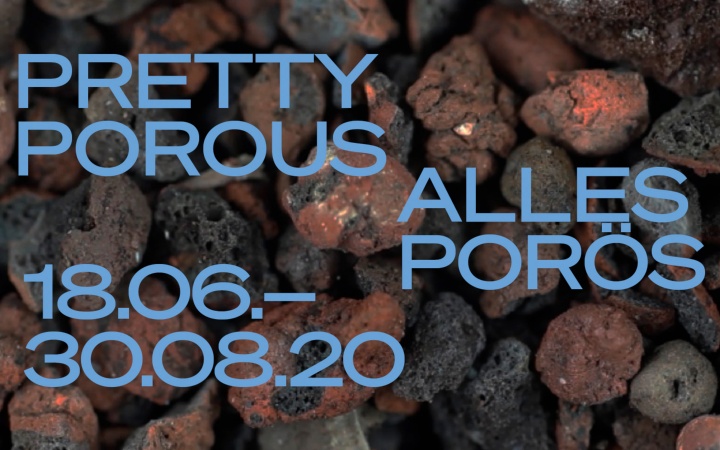The new science exhibition “PRETTY POROUS - ALLES PORÖS” uses examples from biology, technology, and the environment to provide insight into the world of porous media and shows how current research makes the invisible visible. The exhibition of the Collaborative Research Center (SFB) 1313 “Porous Media” of the University of Stuttgart is a cooperation with the real-life laboratory “Space Sharing” of the State Academy of Fine Arts Stuttgart (ABK) and with the Cluster of Excellence EXC 2075 “Data-Integrated Simulation Science” (SimTech) of the University of Stuttgart. It will be open to the public from June 18 to August 30, 2020 in the Spektralsaal of the Planetarium Stuttgart.
We cordially invite media representatives to the press conference that will be taking place before the official opening on June 18, 2020:
Time: Monday, June 15, 2020, 3 p.m.
Location: Planetarium Stuttgart, 25 Willy Brandt Strasse 25, 70173 Stuttgart
Your conversation partners will be Prof. Rainer Helmig, spokesperson of the SFB 1313 of the University of Stuttgart, Prof. Thomas Ertl, spokesperson of the Cluster of Excellence EXC 2075 of the University of Stuttgart, Dr. Uwe Lemmer, Director of the Planetarium Stuttgart and the architects Natascha Peinsipp and Felix Steinhoff from ABK.
Due to corona and the resulting hygiene and distancing concept we ask you to register in advance: hkom@hkom.uni-stuttgart.de
Porous media
“In our everyday life we actually find porous media everywhere,” says Prof. Rainer Helmig, spokesman of the SFB 1313 at the University of Stuttgart. “Virtually anything can be porous: different materials such as paper, asphalt, rock, and plastic, but also the soil on which we stand, and of course we humans with skin and hair. Porous media have one thing in common: They have a cavity structure. If you look at them under the microscope, their permeability (porosity) can be seen very clearly. Gases and liquids can simply flow through them. The SFB 1313 of the University of Stuttgart has set itself the task of better understanding these flow, transport, and deformation processes in porous media. After all, “the findings from our interdisciplinary research could play a role in a wide range of applications in the future. For example in the environment (The natural subsoil as a storage medium), in biology (The therapy for the treatment of osteoporosis), and in technology (The fuel cell as a mobility alternative of the future),” says Helmig. In order to bring the relevance of the research to a broad audience - from children and families to senior citizens - and to create an awareness of porous media, these topics will be presented in the exhibition “PRETTY POROUS - ALLES PORÖS” in an easily accessible and understandable way. The exhibition aims to create transparency and make an important contribution to society - especially in the difficult times of corona.
Contents of the exhibition
The exhibition as a “shared space” in the foyer of the Planetarium Stuttgart is conceived as a showcase laboratory and leads the visitors through the, mostly unseen, day-to-day work of the researchers. At a total of seven stations, which are staged like workstations and which are spatially separated from each other by suspended, permeable vertical blinds, different approaches to the topic of porous media are made accessible: Already at the first station, in the entrance area of the Kepler Hall, visitors are being prepared for the exhibition in terms of content. They learn how the tour is designed, what porous media are, and where we find them in our everyday lives. The tour takes the visitors to the second station, the “forum for meeting and discussion”, where they can sit down, have a coffee, and browse original documents. At the third station the visitors get to know the researchers of the University of Stuttgart and the international network. The fourth station focuses on how porous media are actually researched: how experiments are conducted - whether in the laboratory or on the computer - and how the collected data are converted into models that provide information about invisible processes in porous media. The research triad “analogue experiments - computer models and simulations - visualization” is explained. Stations five to seven deal with three concrete, possible application examples from current research in the field of porous media, which show where the findings can be used. The focus is on topics from biology, the environment, and technology.
The kids’ course - A sponge leads through the exhibition
In order to give children and families in particular a playful approach to the topic of porous media, a kids’ course was developed especially for them. Equipped with a leaflet, they can answer the questions that a talking sponge is asking them at the different stations. Of course the children themselves can ask questions, too.
Vernissage and supporting program of the exhibition
On June 18, 2020, the exhibition will be opened in the Planetarium Stuttgart at 6 p.m. with a virtual vernissage, which can be accessed live. The Collaborative Research Center (SFB) 1313 will introduce itself and then take you on a virtual tour of the exhibition. During the tour, you will have the opportunity to ask questions about the exhibition and its contents via live chat. Parallel to the exhibition, there will be a supporting program with a virtual lecture series that focuses on exciting topics from the world of porous media. The exhibition concept is adapted to the limited opening hours of the planetarium, which may still change due to corona, as well as to its hygiene and distancing concept.
Press contacts
Collaborative Research Center (SFB) 1313 | University of Stuttgart
Partizia Ambrisi
Cluster of Excellence EXC 2075 “SimTech” | University of Stuttgart
Sabine Sämisch
State Academy of Fine Arts Stuttgart (ABK)
Kristina Pauli



